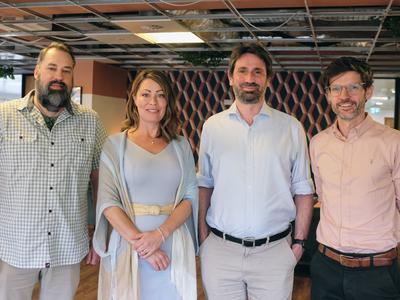
CameraForensics partner with Onemi-Global Solutions to fight pervasive online child exploitation
By the CameraForensics team
29 June, 2023
By Jim Cole from Onemi-Global Solutions

Having recently retired from 35 years of government/law enforcement experience, I have spent a considerable amount of my efforts at the intersection of software development and law enforcement, and I am acutely aware of the knowledge gap that exists between these two worlds.
This gap can have serious consequences, particularly when it comes to cases involving child sexual exploitation and abuse material, where I spent much of my career working and leading. Below, I’ve set out to explore the impact of the knowledge gap, the role of stakeholders in closing it, and possible strategies for bridging the gap through collaboration and knowledge sharing.
To understand the knowledge gap between software and law enforcement, it’s important to first consider the nature of these two fields.
Law enforcement officials are tasked with investigating and prosecuting crimes, while software developers create the tools that enable investigations to be more efficient and effective. However, these two worlds often operate in isolation from one another, with little communication or collaboration.
This lack of collaboration can have serious consequences. For example, when it comes to cases involving child sexual exploitation and abuse material, law enforcement officials rely heavily on the tools created by software developers to help them safeguard victims and arrest perpetrators.
However, these tools are only effective if they are used correctly and to their fullest potential.
If law enforcement officials don’t have a clear understanding of how these tools work, or if they are not trained to use them effectively, then cases can go unsolved and perpetrators can continue to harm children. The knowledge gap can also affect software developers too, who – without an understanding of the core challenges investigators face – may not be able to optimise their tools for maximum efficacy.
The knowledge gap between software developers and law enforcement is particularly noticeable when it comes to cases involving child sexual exploitation and abuse material. These cases are often complex, requiring a high level of expertise to investigate and prosecute. In these cases, perpetrators are often early adopters of available technology, with law enforcement almost always trying to catch up.
Additionally, law enforcement is often overwhelmed by the investigative and administrative burdens placed on them. This can lead to a lack of training availability, which can cause investigators to ineffectively or incorrectly use tools, with serious consequences such as:
In some serious cases, this knowledge gap may even result in perpetrators evading identification and going free.
Given the importance of technology tools in child sexual exploitation and abuse material investigations, it’s clear that software developers have a critical role to play in closing the knowledge gap. They have a wealth of expertise and knowledge when it comes to the tools they develop and can play a key role in helping law enforcement officials to use these tools more effectively.
One way of doing this is through collaborative initiatives and partnerships. Establishing a feedback loop between software developers and law enforcement agencies, the sharing of expertise and knowledge becomes a two-way process.
This ensures that investigators not only have a clear understanding of the tools available to them – and how to use them effectively – but are also able to provide valuable insights to maximise these tools.
Bridging the knowledge gap between software developers and law enforcement fosters stronger partnerships, and facilitating collaboration is more than possible through several approaches.
One possible approach for bridging the knowledge gap involves establishing a feedback loop. This may be through a bulletin board-style platform, where users can easily ask questions, request features, or online tools that enable software engineers and customer care representatives to engage with users.
However, for this approach to succeed, software developers must actively monitor these boards and address user enquiries promptly. This can ensure ongoing interaction and avoid declining trust and ineffective tools.
Another more resource-intensive, but highly rewarding initiative involves organising user summits. These events physically bring together users and company personnel in a shared forum of knowledge exchange and networking.
Training and capacity building for law enforcement officials is also vital. By providing training and resources that help investigators to better understand the tools available to them, tool developers can help to ensure that users always feel supported and confident.
In 2016, as a Supervisory Special Agent running Homeland Security Investigations Victim Identification Program and Laboratory, I had been using CameraForensics for a short time and it was limited to only querying camera make, model and serial number. Images contain many more fields of EXIF data, which can all be useful in an investigation. I started a dialogue with CameraForensics and expressed the need to be able to query more than just camera make, model and serial number. As a result, I was provided with access to the underlying database and given the ability to query all EXIF fields. It wasn’t pretty, but it was powerful.
I came into the lab one morning to messages from colleagues at Task Force Argos in Australia who found an offender who had posted child sexual abuse material of his daughter on a Darknet board. He posted the images with some intact EXIF information which came from the camera lens but not the camera itself. The make, model and serial number of the lens; a Zuiko digital 45mm f1.8.
I accessed the CameraForensics backend database and queried this information, resulting in the discovery of innocuous images taken with the same lens on Flickr. Through this discovery, we were able to see the make, model and serial number of the camera and the user had input “author” information which included a name and an email address. The rest was simple online investigative research to determine who he was and where he resided.
In less than an hour of receiving the lead, Mr. NAWAK (not his real name) was fully identified, his daughter was identified, and we were on the phone with the national police force of the country he resided in handing over the referral for them to take action on. Later that day, NAWAK was arrested, and his daughter was safeguarded. NAWAK was charged with 21 counts of child rape and child exploitation crimes. He would later be sentenced to 22 years in prison, a significant sentence in the country where he was charged.
Upon the successful investigation, arrest of NAWAK and safeguarding of the child, I provided feedback to Matt and Dave at CameraForensics. As a result, they decided to integrate the full search features into their primary tool for everyone to have access to, contributing to the closure of an untold number of investigations.
This is just one example of how close communication, collaboration and feedback can improve the landscape for law enforcement, enabling users to be more effective at combatting child sexual exploitation. This success is due in large part to the company’s commitment to thought leadership and collaboration with law enforcement at any opportunity possible.
Looking to the future, there are many opportunities for new technology to help drive collaboration and close the knowledge gap between software and law enforcement.
Developing new tools that take advantage of the latest innovation, law enforcement officials may more effectively investigate and prosecute cases. Just one example of this recent innovation is Artificial Intelligence (AI).
AI has transformed numerous areas within law enforcement, particularly in the realm of combatting child sexual exploitation. With a wide range of capabilities, AI is a vital tool that’s able to scan and analyse enormous amounts of data, such as digital images and online communication, far quicker than any human could.
For the law enforcement sector, machine learning models have been developed to recognise patterns and detect explicit content, identifying potential risks in the process. AI’s application extends further, assisting in the processing and sorting of extensive evidence within investigations and legal proceedings.
By highlighting relevant details from this vast information pool, AI capabilities can greatly aid investigations. However, with AI capabilities rising sharply, technology companies and law enforcement must work together to ensure the ethical and appropriate use of AI.
The knowledge gap between software development and law enforcement is a critical issue that has serious consequences for cases involving child sexual exploitation and abuse material. However, through collaboration and knowledge sharing, we can work to close this gap and ensure that law enforcement officials have the tools and resources they need to protect children and hold perpetrators accountable.
The case of the NAWAK investigation exemplifies the transformative impact of this collaboration, leading not only to the apprehension of a child sexual abuser, but also inspiring further enhancements in investigative software.
The importance of fostering a symbiotic relationship between software developers and law enforcement is indisputable, promising to enable a more powerful fight against child sexual exploitation.
Jim Cole is a Founding Partner of Onemi-Global Solutions, a consulting firm providing real-world experience-based guidance to assist organisations in their mission to combat child sexual exploitation and support those who are directly engaged in the fight against it.
Throughout our careers, we have earned a reputation for delivering high-quality, operational, innovative solutions within government and are now focused on delivering guidance and products tailored to the unique needs of our clients. For more information, visit www.onemi-global.com.